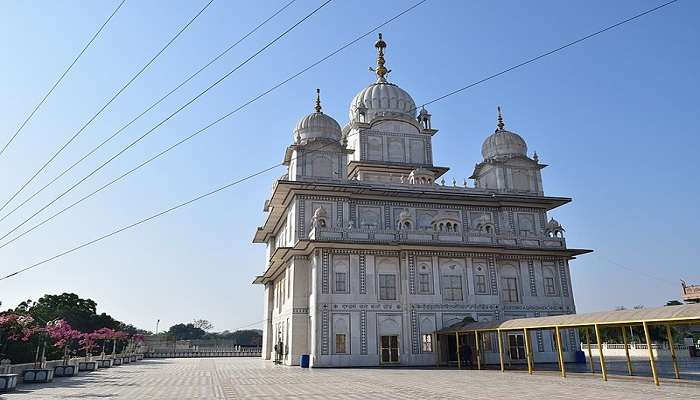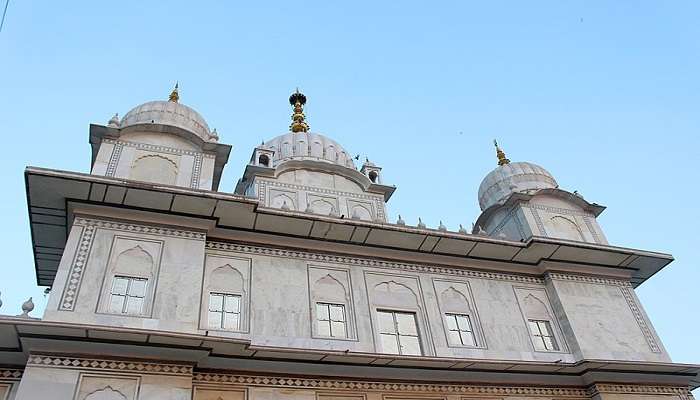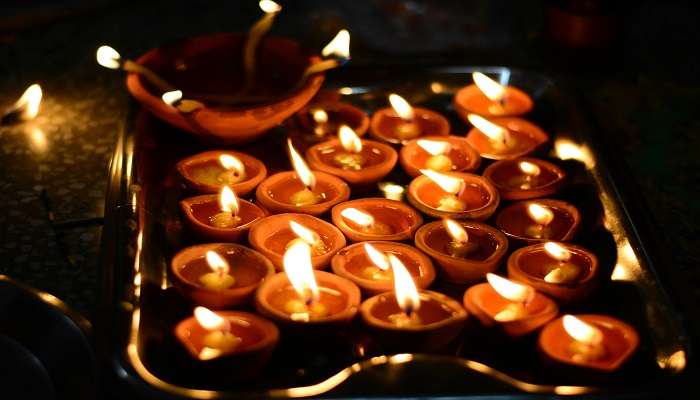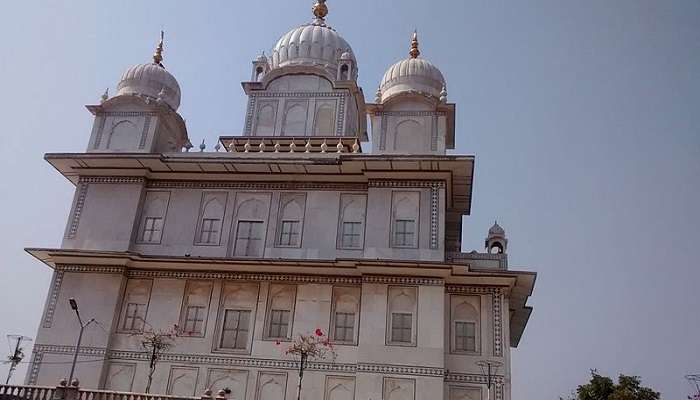Visit The Gurudwara Data Bandi Chhor Sahib To Take Blessing From Guru Hargobind In 2026

Nestled in the historical city of Gwalior, Madhya Pradesh, the revered Gurudwara Data Bandi Chhor Sahib symbolises Sikh heritage, valour, and unwavering faith. This sacred shrine commemorates an extraordinary episode in Sikh history, where the sixth Sikh Guru, Guru Hargobind Sahib Ji, was imprisoned and later freed from the formidable Gwalior Fort. The term “Bandi Chhor” translates to “the liberator of prisoners,” reflecting Guru Hargobind’s generous act of securing the release of 52 Hindu princes alongside his freedom. As you step into the sanctified premises of this Gurudwara, you’re not just entering a place of worship; you’re immersing yourself in a profound narrative of justice, sacrifice, and the enduring quest for liberty. This article will delve into Gurudwara Data Bandi Chhor Sahib’s rich history, architectural splendour, and spiritual significance.
About Gurudwara Data Bandi Chhor Sahib

Gurudwara Data Bandi Chhor Sahib, situated atop Gwalior Fort in Madhya Pradesh, is a revered Sikh pilgrimage site. Its significance stems from the imprisonment of Guru Hargobind Sahib, the sixth Sikh Guru, by Mughal emperor Jahangir.
“Data Bandi Chhor” literally means “giver, breaker of chains.” It refers to Guru Hargobind’s celebrated release and the liberation of 52 Rajput kings imprisoned alongside him for years. The story goes that Guru Hargobind refused to leave when the emperor offered freedom unless the kings were also released. To accommodate this, he had a special robe with enough ends for all 52 kings to hold onto, ensuring their release.
The Gurdwara commemorates this act of compassion and defiance. The original Gurdwara site was a simple marble platform, but the complex, sprawling over six acres, was constructed in the 1970s and 80s. The buildings feature a serene, high-ceilinged hall and a central sanctum. The Gurdwara is a popular pilgrimage destination, especially during the festival of Diwali, which coincides with the anniversary of Guru Hargobind’s release. Throughout the year, devotees and tourists visit the Gurdwara to experience its peaceful atmosphere and pay homage to the Guru’s legacy.
Must Read: Places To Visit Near Gwalior
History Of The Gurudwara

Guru Hargobind Sahib’s father, Guru Arjan Dev, was arrested under the orders of the Mughal Emperor Jahangir and was asked to convert to Islam. His refusal resulted in his torture and execution in 1606 CE. This event is considered a defining moment in the history of India and Sikhs, known as the martyrdom of Guru Arjan. Following the execution, Guru Hargobind succeeded his father as the next Guru of Sikhs. On June 24, 1606, at the age of 11, Guru Hargobind was crowned as the sixth Sikh Guru. During his succession ceremony, he donned two swords: one symbolizing his commitment to maintaining spiritual authority (piri) and the other representing his temporal authority (Miri). Due to the execution of Guru Arjan by Mughal Emperor Jahangir, Guru Hargobind he opposed the oppression of Mughal rule. He counselled Sikhs and Hindus to arm themselves and fight. The tragic death of his father at the hands of Jahangir motivated him to emphasize the military dimension of the Sikh community.
There are varying accounts of how Jahangir imprisoned Guru Hargobind at Gwalior Fort. One version suggests that Murtaja Khan, the Nawab of Lahore, observed that the Guru had constructed the Sri Akal Takhat Sahib, ‘The Throne of the Almighty’, in Amritsar and was also strengthening his army. He informed the Mughal Emperor Jahangir about these developments. The Nawab also stressed that the Sikh Guru was making preparations to avenge his father’s torture and martyrdom. Upon hearing this, Jahangir immediately dispatched Wazir Khan and Guncha Beg to Amritsar to apprehend Guru Hargobind.
However, instead of arresting him, Wazir Khan, who happened to be an admirer of Guru Hargobind, requested the Guru to accompany them to Delhi, stating that Emperor Jahangir wished to meet him. The young Guru accepted the invitation and soon arrived in Delhi, where Jahangir imprisoned him at the Gwalior Fort in 1609. An alternative version attributes Guru Hargobind’s imprisonment to the pretext that the Sikhs and Guru Hargobind had not paid the fine imposed on Guru Arjan. The duration of his imprisonment remains unclear. His release is believed to have occurred in either 1611 or 1612, when Guru Hargobind was approximately 16 years old. Persian records, such as Dabistan I Mazahib, suggest he was incarcerated between 1617 and 1619 in Gwalior, after which he and his camp were kept under surveillance by Jahangir’s Muslim army. According to some accounts, upon his release, Guru Hargobind travelled to Amritsar, where people were celebrating the festival of Diwali. This significant event in Sikh history is now commemorated as the Bandi Chhor Divas festival.
The Architecture of Gurudwara Data Bandi Chhor Sahib

Gurudwara Data Bandi Chhor Sahib in Gwalior boasts a relatively recent yet impressive architectural style. Built-in the 1970s and 80s, the complex sprawls over six acres, showcasing modern features and influences from traditional Sikh architecture. The most prominent element is the dazzling white marble that adorns the buildings. This creates a sense of purity and grandeur, reflecting the spiritual significance of the gurudwara. The central dome, a hallmark of Sikh architecture, dominates the skyline. Its intricate floral and geometric patterns are likely etched or carved, adding a touch of artistic detail.
The entrance gateway, likely a large structure, features traditional arched openings and decorative flourishes. Flanking the main building are additional structures housing a langar hall (community kitchen) and a museum showcasing Sikh history. These buildings might incorporate red sandstone or other contrasting materials to create visual interest.
The Darbar Sahib (sanctum sanctorum) is the focal point within the gurudwara. It houses the Guru Granth Sahib, the holy scripture of Sikhism, on a raised platform. The walls and ceiling of the Darbar Sahib are adorned with colourful frescoes or inlaid with semi-precious stones, depicting scenes from Sikh history or religious symbols. Large, open prayer halls exist alongside the Darbar Sahib, offering ample space for devotees to gather and meditate. These halls feature polished marble floors and large windows, allowing natural light to bathe the interior in a serene glow. The overall design of Gurudwara Data Bandi Chhor Sahib strives to balance grandeur and simplicity.
Suggested Read: Places To Visit In Gwalior
Timings And Way To Reach To Gurudwara

Gurudwara Data Bandi Chhor Sahib is open to visitors all year round, from 5:00 AM to 9:00 PM daily. Devotees can pay their respects and seek blessings from the Guru anytime during the day
Gurudwara Data Bandi Chhor Sahib is situated on top of Gwalior Fort. Below is how you can reach the Gurudwara:
By Road
Gwalior is well-connected by road. You can reach the Gurdwara inside Gwalior Fort by driving or taking a bus.
By Air
Gwalior Airport (GWA) is the nearest airport. From there, you can take a taxi to Gwalior Fort, where the Gurudwara is located.
By Train
Gwalior Junction (GWL) is the nearest central railway station to Gwalior. You can hire a taxi, cab, or rickshaw from the railway station to reach the Gwalior Fort.
Further Read: Things To Do In Gwalior
Gurudwara Data Bandi Chhor Sahib showcases Sikh history and the caring leadership of Guru Hargobind Singh. It also looks into a significant part of India’s diverse culture. Whether you’re a follower, love history, or just curious, visiting this gurudwara will be an enlightening and memorable experience. Ready to explore this historical marvel? Book your trip to Gwalior today and immerse yourself in the spiritual aura of Gurudwara Data Bandi Chhor Sahib. Make sure you see this fantastic building and hear its fascinating story yourself. Plan your visit now and make lasting memories in the centre of Gwalior!
For our editorial codes of conduct and copyright disclaimer, please click here.
Cover Image Source: Kshitiz Sikka for Wikimedia Commons
Frequently Asked Questions About Gurudwara Data Bandi Chhor Sahib
What is the history of Gurdwara Bandi Chor?
Gurdwara Data Bandi Chhor Sahib is associated with Guru Hargobind Sahib, the sixth Sikh Guru. Following the execution of his father, Guru Arjan, by Mughal emperor Jahangir, Guru Hargobind became a symbol of resistance. He was imprisoned in Gwalior Fort between 1617 and 1619. The term 'Bandi' means 'imprisoned', and 'Chhor' means 'release.' Legend says Guru Hargobind Sahib secured the release of 52 other kings imprisoned in the fort. Upon his release, the Gurdwara was established to commemorate this event.
What is the history of Gurudwara at Gwalior Fort?
The Gurdwara Data Bandi Chor Sahib in Gwalior is associated with Guru Har Gobind Sahib’s imprisonment in the Gwalior Fort. He secured the release of 52 Rajas who had long suffered imprisonment there. The word “Bandi” means “imprisoned,” and “Chhor” means “release.” Pilgrims visit this Gurdwara to pay homage to Guru Hargobind, especially during October/November, coinciding with the Diwali Hindu festival. The fort itself has a rich history, existing since at least the 10th century, with inscriptions and monuments suggesting an even earlier origin.
Why do Sikhs celebrate Bandi Chhor?
Bandi Chhor Divas, which falls around October or November, celebrates the release of Guru Hargobind Sahib and the other prisoners from Gwalior Fort. It signifies the triumph of justice and the Guru's commitment to fighting oppression. On this holy day, Sikhs worldwide hold processions, recite scripture continuously, and participate in special prayers and music.
What is the purpose of the Chor sahib?
The Gurdwara serves as a place of pilgrimage for Sikhs. It is a testament to Guru Hargobind's spirit and the Sikh values of courage, justice, and liberation. Visitors come to pray, learn about Sikh history, and experience the peaceful atmosphere.
What is Gwalior famous for?
Gwalior is known for its majestic Gwalior Fort, a sprawling hilltop complex with a centuries-old history. Besides the Gurdwara Data Bandi Chhor Sahib, the fort houses other historical monuments like palaces and temples. Gwalior is also a centre for music and is known for its distinctive style of Hindustani classical music.
People Also Read:
Guru Nanak Darbar Dubai Golden Temple Gurudwara Singh Sabha

Innovative Content Writer Focused on Producing High quality, Original Content that drives traffic and engages readers. Experienced in Content strategy and analytics to measure content performance using tools such as SQL, Power BI, Excel.











